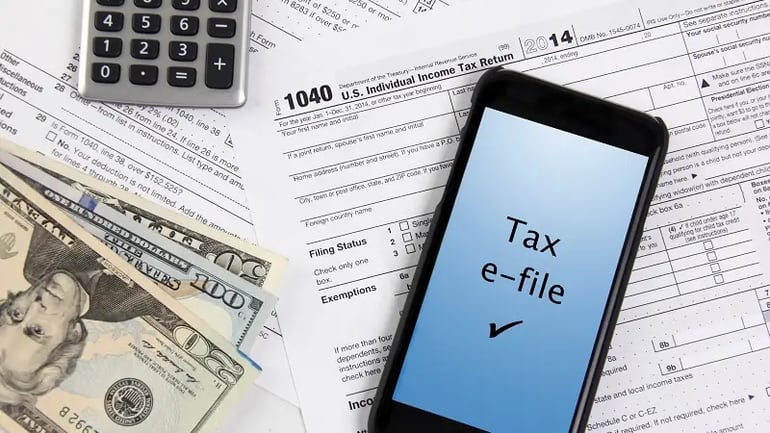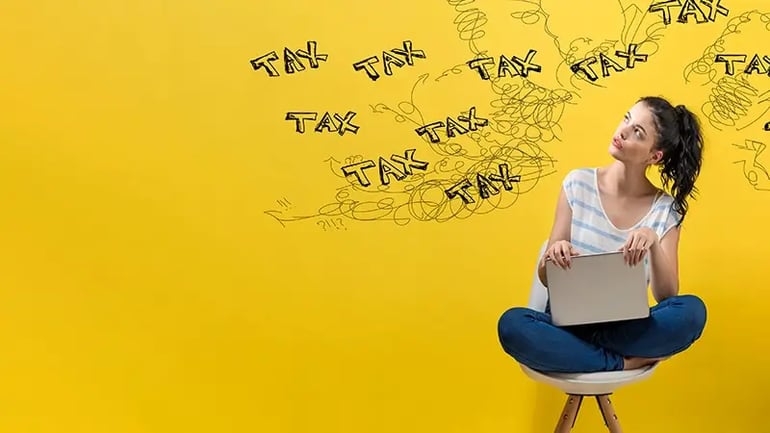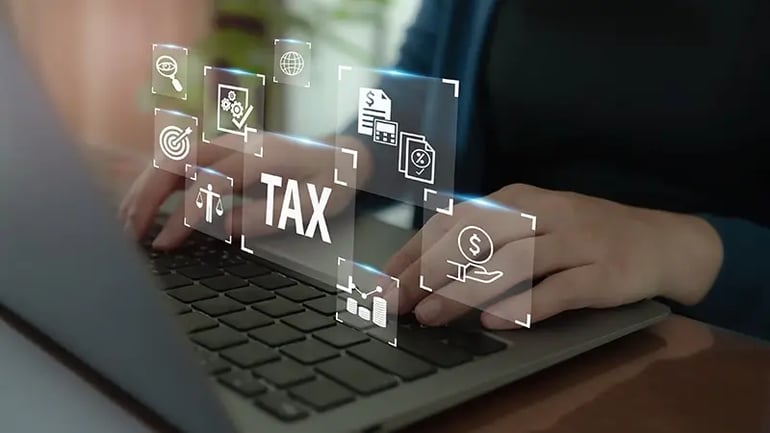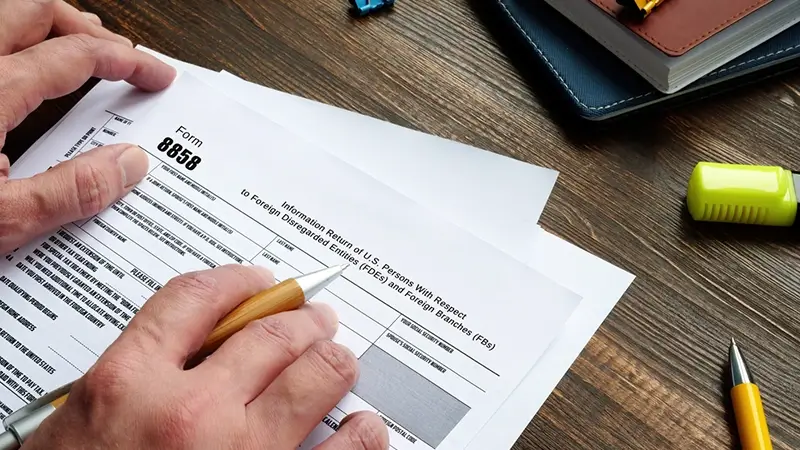Learn all about Form 8858: What is it and who must fill it out?
Certain individuals in the United States who own a foreign disregarded entity (FDE) or foreign branch (FB) may utilize this form and its schedules to...
Who doesn’t love a larger income tax refund? In this blog post, we’ll dive deep into the world of tax refunds and explore various strategies to get the most out of your hard-earned money. From understanding the factors that affect your refund, maximizing deductions and credits, to filing taxes online and handling late payments, we’ve got you covered. So buckle up and get ready to make the most of your tax refund this year!
Understand factors that influence your income tax refund to maximize the amount received.
Use online calculators and deductions/credits, adjust withholding, and select the right tax software to increase refund size.
Utilize free resources or professional services for help with filing taxes, understanding deductions/credits, handling late payments & penalties.

Your income tax refund is the amount of money you receive from the government when you’ve paid more taxes than you owe. It’s essential to grasp the factors that influence your tax refund to optimize it and get the most out of your hard-earned money, especially when filing your tax returns.
In the following sections, we’ll dive into the various factors that affect your refund and provide guidance on how to estimate it. Understanding the factors that influence your tax refund, such as deductions, credits, and withholding, can help you make informed decisions to maximize your refund.
Additionally, estimating your refund using online tools can assist you in making better financial decisions throughout the year, both personally and in your business.
To check the status of your federal tax refund, you can use the official IRS (Internal Revenue Service) online tool called "Where's My Refund?" Here's how you can access it:
Your Social Security or taxpayer ID number
Your filing status
The exact refund amount on your return
The IRS information is updated once a day, overnight.
Please note that it may take some time for the IRS to process your refund, so if you have recently filed your tax return, it is possible that the status may not be available immediately.
To determine when you can expect your federal tax refund, you should consider several factors. First, the method you used to file your tax return will play a role. If you filed electronically and opted for direct deposit, you generally receive your refund more quickly, typically within three weeks. However, if you filed a paper return and requested a paper check, it may take longer, usually around six to eight weeks. Additionally, the timing may vary based on the volume of returns being processed by the Internal Revenue Service (IRS) at a given time and any potential delays or issues specific to your return. To get the most accurate information regarding your refund status, you can use the "Where's My Refund?" tool on the IRS website or the IRS2Go mobile app.
Where's My Refund Status: https://www.irs.gov/refunds
Several factors can impact the size of your tax refund. These include your income level, filing status, the amount of taxes withheld from your paycheck, deductions, and credits you claim. For example, if you’re eligible for deductions like medical expenses or credits such as the Earned Income Tax Credit, these can significantly reduce your tax liability and increase your refund.
It’s also important to note that withholding plays a vital role in determining your tax refund. The more taxes are withheld from your paycheck, the smaller your refund will be, and vice versa. Therefore, it’s crucial to adjust your withholding to strike the right balance between owing taxes and receiving a large refund.
Estimating your tax refund can be done easily using free online tax calculators. These tools require you to answer a few simple questions regarding your income, deductions, and credits to calculate an estimate of your refund. By providing accurate information, you can obtain a precise estimate and make better financial decisions throughout the year.
Online tax calculators also offer advice and guidance on how to maximize your refund. For instance, they might suggest claiming additional deductions or credits you weren’t aware of, or adjusting your withholding to optimize your refund. To get a comprehensive understanding of your refund calculation, you can also consult the IRS website or a tax professional.

Now that we’ve discussed the factors affecting your tax refund, let’s explore some strategies to maximize it. The key to getting a larger refund is taking advantage of deductions and credits, adjusting your withholding, and finding the right tax software to file your taxes online.
Reconsidering your filing status, claiming applicable deductions and credits, and making retirement contributions are just a few ways to maximize your tax refund. In the following sections, we’ll delve into these strategies in more detail.
Deductions and credits are essential tools in reducing your tax liability and increasing your refund. Deductions lower your taxable income, while credits directly reduce the amount of taxes owed. By claiming deductions and credits, you can significantly increase your refund.
To claim deductions and credits, you’ll need to complete the relevant forms and include them with your tax return. The necessary forms can be found on the IRS website. Examples of common deductions and credits include the Child Tax Credit, Earned Income Tax Credit, Charitable Contribution Deduction, and American Opportunity Tax Credit.
Withholding refers to the deduction of funds from an employee’s paycheck by their employer, which is then remitted to the Internal Revenue Service. Adjusting your withholding can have a significant effect on your income tax refund. By increasing your withholding, you’ll be entitled to a larger refund when you file your taxes. Conversely, if you decrease your withholding, you’ll receive a smaller refund or may even owe money to the IRS when you file your taxes.
To adjust your withholding, you’ll need to complete a new W-4 form with your employer. Adjusting your withholding has its advantages, such as obtaining a larger refund or avoiding owing taxes when you file your taxes. However, it’s important to be cautious, as not having enough money withheld from your paycheck could potentially lead to owing taxes when filing your taxes.

Filing your taxes online is a quick, efficient, and accurate way to submit your tax return. It can also lead to faster refunds and easier compliance with reporting and disclosure regulations. In this section, we’ll discuss how to file your taxes online, including choosing the right tax software for your needs and making the process smoother.
The filing process involves gathering the required documents, selecting the appropriate tax software, and submitting your return. In the following subsections, we’ll explore how to choose the right tax software and offer tips for filing online.
There are several top-rated tax software options available, such as TurboTax and H&R Block. TurboTax is the top choice overall, while H&R Block offers the unique advantage of providing assistance from a tax professional in person. When evaluating tax software options, consider features such as ease of use, accuracy, customer support, and cost, along with additional features like audit protection, data import capabilities, and the ability to file multiple returns.
Selecting the right tax software for your needs depends on your filing situation, budget, and the features offered by each software. Reading reviews and comparing prices can help determine the best fit for you.

Before you begin filing your taxes online, gather all necessary documents, such as your W-2, 1099s, and other income documents, as well as any deductions or credits you’re claiming. Filing your taxes electronically with direct deposit is the most efficient way to submit your taxes online and avoid delays in receiving your refund.
To ensure the accuracy of your information, double-check it before submitting your taxes online. By following these tips and using the right tax software, you’ll be well on your way to a smooth and successful online tax filing experience.
If you’ve missed the tax filing due dates or face penalties for late payments, it’s important to know how to handle these situations. Late payments and penalties can lead to additional charges, such as failure-to-file and failure-to-pay penalties, which can negatively affect your credit score.
In this section, we’ll discuss how to calculate penalties and interest for late payments and explore payment plan options. Calculating penalties and interest for late payments is crucial to understanding the full extent of your tax liability. In the following subsections, we’ll explain how to calculate these charges and discuss the available payment plan options.
Penalties and interest are additional charges imposed by the IRS for late payments or filing taxes after the due date. These charges are calculated as a percentage of the unpaid taxes for each month or part of a month where the tax remains unpaid. To calculate penalties and interest for late payments, you can use the formula provided by the IRS, which includes a failure-to-pay penalty of 0.5% per month and a late payment penalty of 0.5% of the tax owed after the due date.
For example, if you’re late in paying a tax liability of $1,000 by two months, the failure-to-pay penalty would amount to $10 (1% of $1,000 for each month), and the late payment penalties would be $5 (0.5% of $1,000 for each month).
For a comprehensive understanding of penalty and interest calculations, consult the IRS website or a tax professional.
If you’re unable to pay your taxes in full by the deadline, several payment plan options are available to help you manage your tax debt. These options include credit and debit card payments, cash, mobile wallets, bank transfers, and installment payment plans.
An installment payment plan is a payment arrangement that allows taxpayers to pay their taxes in multiple installments over a specified period. Payment plans can help taxpayers manage their tax debt, avoid penalties and interest, and prevent the need to obtain a loan to pay their taxes.
To explore payment plan options, consult the IRS website or a tax professional.

Once you’ve filed your taxes and maximized your refund, it’s time to think about how to receive and use your tax refund wisely. In this section, we’ll compare the benefits of receiving your tax refund via direct deposit or paper check and discuss smart ways to use your refund.
Receiving your tax refund can be done through direct deposit or paper check, each with its own set of advantages. In the following subsections, we’ll delve deeper into these options and provide suggestions for smart ways to use your refund.
Direct deposit is a faster, more secure, and cost-effective method of receiving your tax refund compared to paper checks. Funds are deposited directly into your bank account, eliminating the risk of a lost or stolen check. Additionally, there are no fees associated with direct deposit.
On the other hand, paper checks offer the advantage of tracking, as the check can be visible and kept as a record of payment. Paper checks can also be used to pay bills or make purchases where direct deposit is not an option.
Ultimately, the choice between direct deposit and paper check depends on your personal preferences and needs.
A tax refund can be a significant financial windfall, and it’s essential to use it wisely. Some smart ways to use your refund include paying off high-interest debt, bolstering an emergency fund, investing in retirement savings, or donating to a charity. By using your refund to pay off debt, you can minimize the amount of interest accrued over time, free up funds for other expenses, and improve your credit score.
Another prudent approach to using your refund is investing in your future. This can be done by contributing to a retirement account, setting aside funds for a large purchase, or investing in a diversified portfolio. By carefully considering your financial goals and needs, you can make the most of your tax refund and improve your financial well-being.

Navigating the world of taxes can be challenging, but you don’t have to go it alone. There are various tax help resources available, including free tax assistance programs and professional tax services. In this section, we’ll introduce you to some of these resources and help you find the right one for your needs.
Whether you need assistance with filing your taxes, understanding deductions and credits, or handling late payments and penalties, there’s a tax help resource out there for you. In the following subsections, we’ll discuss free tax assistance programs and professional tax services in more detail.
Several organizations offer free tax assistance programs to help individuals and families file their taxes and answer tax-related questions. Some of the most prevalent programs include the IRS’s Volunteer Income Tax Assistance (VITA) and Tax Counseling for the Elderly (TCE) programs, IRS Free File, and VITA and Tax-Aide.
These free tax assistance programs provide valuable resources to taxpayers, especially those with limited income or facing complex tax situations. To find a program that suits your needs, visit the IRS website or the websites of organizations offering these services.

If you prefer a more personalized approach to tax help, professional tax services such as H&R Block, Jackson Hewitt, and Liberty Tax are available to assist you in maximizing your tax refund and navigating complex tax situations. These services provide tax preparation and filing assistance, ensuring your taxes are filed accurately and on time.
By utilizing professional tax services, you can benefit from the expertise of experienced tax professionals who can identify deductions and credits you may have overlooked. With the right tax help resource, you can optimize your refund and feel confident in your tax filing process.
In conclusion, understanding and maximizing your income tax refund is an essential aspect of personal finance. By exploring factors affecting your refund, utilizing deductions and credits, adjusting withholding, and filing your taxes online, you can optimize your tax refund and make the most of your hard-earned money. Don’t forget to take advantage of tax help resources, whether it’s free tax assistance programs or professional tax services, to ensure the most accurate and efficient tax filing experience. Now go forth and conquer your taxes like a pro!
At H&CO, our experienced team of tax professionals (CPAs) understands the complexities of income tax preparation and is dedicated to guiding you through the process. With a personalized approach, we help you navigate US and international income tax laws, staying up to date with the latest changes.
For over 30 years, our bilingual trusted CPA Tax Advisors have provided exceptional income tax services to individuals, families, real estate investors, family offices, small business owners, multinationals, and foreign individuals. Our goal is to ensure you take advantage of all available deductions and credits, minimizing your tax liability effectively.
With offices in Miami, Coral Gables, Aventura, and Fort Lauderdale, our CPAs are readily available to assist you with all your income tax planning and tax preparation needs. To learn more about our accounting firm services take a look at our individual tax services, business tax services, international tax services, expatriate tax services, SAP Business One, entity management, human capital and audit and assurance services.
Trust H&CO for reliable and comprehensive income tax services that bring you peace of mind.
You can easily check the status of your tax refund online by visiting the IRS Where’s My Refund tool or using the IRS2Go mobile app. You’ll need to provide your Social Security number, filing status and exact refund amount to access your information.
You can also call the IRS for an update on your refund status.
Refunds are generally issued within 21 days when you electronically file your tax return, and up to six to eight weeks when you paper file your return.
The fastest way to get your refund is to e-file and choose direct deposit.
Tax refunds are money that taxpayers get back from the government after they have overpaid their income taxes. The refund is determined by filing a tax return and subtracting any taxes owed from any taxes withheld throughout the year.
Millions of taxpayers each year receive a refund due to over-withholding from their paycheck.
Unfortunately, no. You can use the IRS Where’s My Refund? Use the IRS2Go mobile app to check your refund online and you can also call the IRS to check on the status of your refund. However, the systems are only updated once every 24 hours so it could take a few weeks for you to receive a response.
Based on current IRS filing and processing times, you can likely expect to receive your 2023 tax refund by early March of that year.

Certain individuals in the United States who own a foreign disregarded entity (FDE) or foreign branch (FB) may utilize this form and its schedules to...

In an increasingly interconnected world, international trade and investment play a vital role in economic growth and business expansion. However,...

The United States-Canada Income Tax Treaty is a cornerstone for cross-border trade, investment, and cooperation between these two economic giants....
